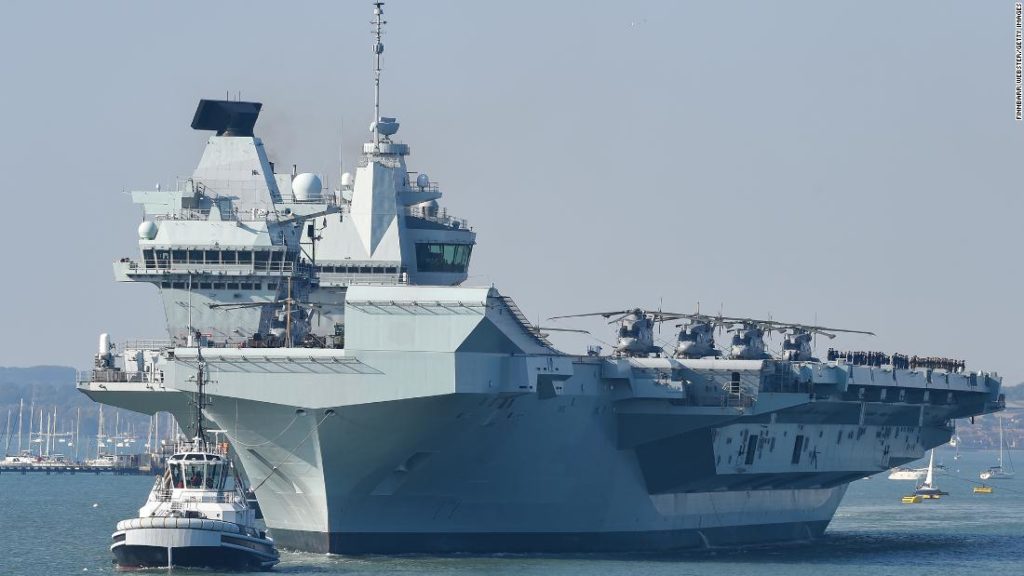The designation means the 65,000-ton carrier, its air assets including F-35 stealth fighter jets and helicopters, as well as its escorting destroyers, frigates, submarines and supply ships, are ready to deploy within five days of receiving orders to do so.
Qualified pilots and ground crews are on notice.
The commander of carrier strike group, Commodore Steve Moorehouse, touted his unit’s readiness in a Twitter post.
“In practical terms, my Strike Group is now at Very High Readiness, meaning we are at 5 days’ notice to deploy, if required, in response to global events & in defence of British interests,” Moorehouse tweeted.
In a followup tweet, he hinted at what is to come. Carrier strike group staff are planning for the Queen Elizabeth’s first operational deployment, which Moorhouse said would encompass the Royal Navy’s largest peacetime task group in 25 years and be proof of Britain’s commitment to maintaining worldwide security — “a visible demonstration of Global Britain,” Moorhouse called it.
Specific dates for the first deployment have yet to be announced.
UK as a global power
Since 2017, UK defense officials have been saying the carrier’s first deployment would include Asia and the Pacific on a route from Britain that would likely take it through the South China Sea.
The carrier would take its contingent of state-of-the-art F-35 stealth fighter jets into a region where “China is developing its modern military capability and its commercial power,” Williamson said in an address to the Royal United Services Institute think tank in London.
But the presence of any foreign warships in the South China Sea is frowned upon by China. Beijing claims almost all of the 3.3 million square kilometer (1.3 million square mile) South China Sea as its territory.
Even ahead of Monday’s Royal Navy readiness announcement, Chinese military officials were warning London against interfering in the region.
“The Chinese military will take necessary measures to protect national sovereignty, security, and its developmental interests, as well as safeguard peace and stability in the region,” he said.
NATO and the Chinese threat
“China has an increasingly global strategic agenda, supported by its economic and military heft. It has proven its willingness to use force against its neighbors, as well as economic coercion and intimidatory diplomacy well beyond the Indo-Pacific region,” the NATO report said.
“China is increasingly likely to project military power globally, including potentially in the Euro-Atlantic area.”
Yet a British presence in the South China Sea is not without precedent. In 2018, the Royal Navy amphibious assault ship HMS Albion steamed closed to the Chinese-claimed Paracel Islands in the South China Sea in what Beijing called a “provocative action.”
The UK-US cooperation is expected to continue with the carrier’s upcoming deployment to the Asia-Pacific.
When the Queen Elizabeth held large-scale exercises in the Atlantic last fall, US Marine Corps F-35B fighter jets and Royal Navy F-35s were on board — forming the largest concentration of fifth-generation stealth fighters ever as sea. That same aircraft contingent is planned for the Pacific deployment.
As those exercises for the carrier strike group began, Moorhouse, its commander, noted the significance.
“Protected by a ring of advanced destroyers, frigates, helicopters and submarines, and equipped with fifth-generation fighters, HMS Queen Elizabeth is able to strike from the sea at a time and place of our choosing; and with our NATO allies at our side, we will be ready to fight and win in the most demanding circumstances,” he said in a statement last fall.
You may also like
-
Afghanistan: Civilian casualties hit record high amid US withdrawal, UN says
-
How Taiwan is trying to defend against a cyber ‘World War III’
-
Pandemic travel news this week: Quarantine escapes and airplane disguises
-
Why would anyone trust Brexit Britain again?
-
Black fungus: A second crisis is killing survivors of India’s worst Covid wave

